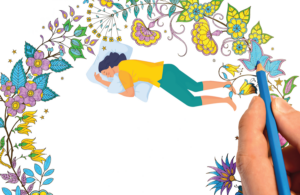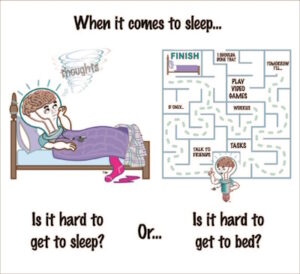The ADHD Dream to Dream
Jeff Copper, MBA, PCC, PCAC, ACG, CPCC
Download PDF
Ah! There’s nothing like awakening from a deep, restful sleep. We feel alert, motivated, and excited to face the day.
Psychologist Roberto Olivardia has described sleep as defragmentation for the brain. Defragmentation is a process where a computer rearranges the data on the hard drive to make information easier to find. In short, it organizes things. I can relate to this. I know when I am sleep deprived. My brain is foggy. I’m spinning around, looking for information in the clutter of my mind.
 Sleep, restful sleep, is a major challenge for individuals with ADHD. Further, sleep deprivation taxes executive function, which is the underlying ADHD impairment. In short, it makes ADHD symptoms worse, which makes life more challenging, cascading into more stress, worry, and sleep difficulties.
Sleep, restful sleep, is a major challenge for individuals with ADHD. Further, sleep deprivation taxes executive function, which is the underlying ADHD impairment. In short, it makes ADHD symptoms worse, which makes life more challenging, cascading into more stress, worry, and sleep difficulties.
Exercise can help with sleep. In the end, if exercise could be put into a pill, it would be the ADHD drug of the century. Not only is exercise good for executive function, but it helps tire the body and makes it easier for the mind to surrender itself to sleep.
In general, conventional wisdom will preach the benefits of good sleep hygiene and minimizing screen time, as well as getting tested for sleep conditions such as apnea. I agree.
 As an ADHD coach and student of psychologist Russell Barkley’s construct, which defines ADHD as an executive function impairment, I go a bit deeper to define the problem, identify the root cause, and work with clients to problem-solve. In short, the ADHD brain is a reflection of the emotional, reward-driven brain. In other words, it doesn’t deal with discomfort.
As an ADHD coach and student of psychologist Russell Barkley’s construct, which defines ADHD as an executive function impairment, I go a bit deeper to define the problem, identify the root cause, and work with clients to problem-solve. In short, the ADHD brain is a reflection of the emotional, reward-driven brain. In other words, it doesn’t deal with discomfort.
People with ADHD struggle with boredom more than those who are neurotypical. Boredom has been defined as the physical discomfort where one is motivated to escape it. In other words, if those with ADHD are uncomfortable or bored, they will seek comfort, even if what is comforting is something they shouldn’t do. Think of it like this: It takes an enormous amount of cognitive energy to sit in pain when all we want is to seek relief.
In general, when you lay your head on the pillow, it should take fifteen minutes for your brain to surrender itself to sleep. For most individuals with ADHD, those fifteen minutes are agonizingly boring (uncomfortable). Reflexively, the ADHD brain seeks something to entertain itself until it passes out from exhaustion. When people come to me wanting coaching around getting out of bed in the morning, my go-to question is, What is your brain entertaining itself with in the evenings? Awkward pause!
 The problem is that they can’t get up in the morning because their brain is exhausted. It has been entertaining itself at night to escape the discomfort of lying with the head on the pillow. Thus, boredom is often the root cause of the problem. This is where everyone wants a tip, trick, or strategy that often fails, because it doesn’t account for the individual differences in brain preferences. In such times, it is much more effective to problem-solve.
The problem is that they can’t get up in the morning because their brain is exhausted. It has been entertaining itself at night to escape the discomfort of lying with the head on the pillow. Thus, boredom is often the root cause of the problem. This is where everyone wants a tip, trick, or strategy that often fails, because it doesn’t account for the individual differences in brain preferences. In such times, it is much more effective to problem-solve.
The idea is to find something to feed your brain in the evening that is interesting enough not to fall into the boredom trap, but not too stimulating where the brain won’t surrender itself to sleep. Kind of like a Post-It note, sticky enough to stick to the wall, but not too sticky to peel off the paint when it’s removed.
How do you find what works? Self-observation and self-awareness. Reflect on the past with things that are calming to you, things that don’t involve a screen. What works depends on you and your brain. That said, here are some examples my clients and I have discovered:
- Adult coloring books.
- Turn off all the lights in the house so it’s pitch black and putting on a miner’s light (flashlight on your head) and do busy work, such as dishes, folding laundry, putting things away, or vacuuming.
- Find a podcast you love and have listened to like a hundred times. Put in earbuds and turn the volume to the point where you can hear it but have to strain to hear it. The idea is it is of interest, but the strain over time will allow you to drift to sleep.
- Play solitaire with actual cards over and over (cheat when you have to).
- Use guided meditation.
- Listen to music, focus only on listening to the bass guitar.
- For me, it is watching thirty minutes of old familiar sitcoms (Frazier, Friends, Last Man Standing, Cheers, Seinfeld). Note that Junkyard Wars, Modern Marvels, or any documentary is a no-go for me.
- Do some knitting, crocheting, or just doodling.
The idea is mindfully managing what your brain entertains itself with in the evening. There’s no guarantee you will slip into one of those amazing, twitching, drooling, deep sleeps I experienced as a kid and long for as an adult, but if sleep hygiene isn’t working, you might find this mindset helpful. Good luck and sweet dreams.
 Jeff Copper is an attention coach and expert on attention issues. He founded DIG Coaching Practice and is host and founder of Attention Talk Radio and Attention Talk Video. He coaches individuals with ADD/ADHD symptoms who are seeking personal and business results by helping them realize their potential. As someone who has had to learn to manage attention and deal with his own challenges, he helps his clients understand themselves and how their minds work. To this end, Copper developed his anatomy of attention construct to help them regain control of their attention and move past barriers. Using his anatomy of attention construct, they can achieve what they are capable of faster, with less stress, and create productive environments they need. Copper received a bachelor’s degree from Indiana University, an MBA from University of Tampa, professional designations from ICF, PAAC, and certification programs at ADDCA and CTI. He is a member of ADDA, CHADD, ACO, PAAC, and ICF, and serves on the editorial advisory board of CHADD’s Attention magazine.
Jeff Copper is an attention coach and expert on attention issues. He founded DIG Coaching Practice and is host and founder of Attention Talk Radio and Attention Talk Video. He coaches individuals with ADD/ADHD symptoms who are seeking personal and business results by helping them realize their potential. As someone who has had to learn to manage attention and deal with his own challenges, he helps his clients understand themselves and how their minds work. To this end, Copper developed his anatomy of attention construct to help them regain control of their attention and move past barriers. Using his anatomy of attention construct, they can achieve what they are capable of faster, with less stress, and create productive environments they need. Copper received a bachelor’s degree from Indiana University, an MBA from University of Tampa, professional designations from ICF, PAAC, and certification programs at ADDCA and CTI. He is a member of ADDA, CHADD, ACO, PAAC, and ICF, and serves on the editorial advisory board of CHADD’s Attention magazine.
Other Articles in this Edition
How to Shift Black-and-White Thinking
ADHD and College: Experiences and Supports
Putting the Skids on Summer Slide
School’s Out: Give Summer Some Structure
Apps Can Help Girls Manage When Hormones Affect ADHD Symptoms
Uniting in Understanding: The Role of Peer Support in ADHD Management
